|
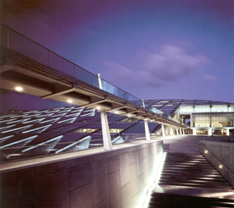 The
principal objective of reviving the Bibliotheca
Alexandrina is to establish a comprehensive
research library of a unique collection and
intention. The new library is designed as a modem
state-of-art translation of the old, adequate for
crossing the frontiers and meeting the challenges
of the 21st. century. It will certainly contribute
to excellence in research and advancement of human
knowledge. The library will become a unique
admired research institution, a haven for
scholars worldwide to produce their quality work
of excellence. The
principal objective of reviving the Bibliotheca
Alexandrina is to establish a comprehensive
research library of a unique collection and
intention. The new library is designed as a modem
state-of-art translation of the old, adequate for
crossing the frontiers and meeting the challenges
of the 21st. century. It will certainly contribute
to excellence in research and advancement of human
knowledge. The library will become a unique
admired research institution, a haven for
scholars worldwide to produce their quality work
of excellence.
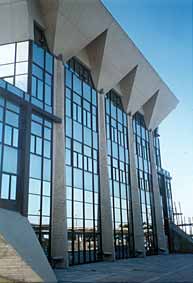 It will also be an
invaluable information resource to support
decision-making and broaden future horizons for
the cultural, social and economic development of
Egypt and the region. Subsequently, the library
will play a needed role to further cooperation
between the north and south of the Mediterranean
Basin. as well as between the east and west. The
Bibliotheca Alexandrina has adopted its collection
development policy in cooperation with UNDPIUNESCO
and with valuable input of national and
international experts, in order to evolve its
unique collection and functions and to avoid
repetition and unnecessary overlapping with other
research libraries regionally or internationally.
Since the famous 1990 Aswan Declaration, UNESCO
and the international community has been
cooperating with the Egyptian Government to
muster resources for the library implementation. It will also be an
invaluable information resource to support
decision-making and broaden future horizons for
the cultural, social and economic development of
Egypt and the region. Subsequently, the library
will play a needed role to further cooperation
between the north and south of the Mediterranean
Basin. as well as between the east and west. The
Bibliotheca Alexandrina has adopted its collection
development policy in cooperation with UNDPIUNESCO
and with valuable input of national and
international experts, in order to evolve its
unique collection and functions and to avoid
repetition and unnecessary overlapping with other
research libraries regionally or internationally.
Since the famous 1990 Aswan Declaration, UNESCO
and the international community has been
cooperating with the Egyptian Government to
muster resources for the library implementation.
Location
The new Bibliotheca Alexandrina has a site of 45
000m2 located in the center of Alexandria across
from the Silsilah Peninsula. This is the location
of the ancient “Royal Quarter”, where the first
library is thought to have been located. A 1993
archaeological survey of thes ite further verifies
the location of this “Royal Quarter”.
The Corniche waterfront avenue and the sea bound
the library site from the north for a length of
305m giving the Library a magnificent view of the
Eastern Harbor. Also, on the site, is the
Conference Center of Alexandria, 5 000m2, which
will augment the facilities of the library.
A brief on the
ancient library of Alexandria
The Ancient Library of
Alexandria was established by Ptolemy I (Soter) in
the year 288 B.C. It was intended as a meeting
place of the most eminent minds of the time who
would gather in the temple of the muses or the
Museum. This was the first research center in the
world. It was a sort of scholarly academy
attracting prominent scientists and intellectuals,
with a library annexed to it. Several buildings
were involved of which the most famous were the
museum, and the library by the waterfront (both in
the royal district called the Brucheion)
and the daughter Library in the Temple of Serapis
(the Serapeum).
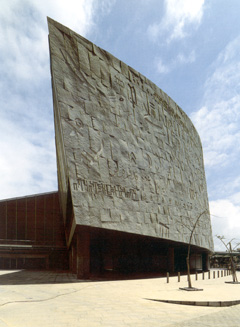
The Library expanded to
include all the knowledge in the ancient world.
The library at its zenith may have had over
700,000 scrolls, and attracted men of letters,
intellectuals, scientists and scholars, inter alia:
-Aristarchus, the first to proclaim that the earth
revolves around the sun.
-Hipparchus, the first to measure the solar year
with six and a half minutes accuracy.
-Eratosthenes, the first to measure the
circumference of the earth.
-Euclid, who wrote the elements of geometry.
-Archimedes, the greatest mathematician of the
Ancient World.
-Callimachus, a poet, and the first to write a
catalogue for books classified by topic and
author, thereby becoming the father of Library
Science.
The Ancient Library of
Alexandria was open to all civilizations.
Systematic efforts were made to collect the best
works from all over the world, and any ships that
docked in Alexandria were searched, and any books
on board were copied. Scholars from all over the
world were invited to come. The Old Testament was
translated for the first time from Hebrew to
Greek.
Thus, the Ancient Library of
Alexandria in its first centuries was a mixture of
all civilizations, and languages, however the
Greek language was most dominant (as English is
today). No doubt, the role of Greek thought and
philosophy was remarkable in formulating the
Hellenistic civilization, for which Alexandria
with its great Library was the intellectual
capital.
The genius of the Hellenistic
Culture was to combine the glory of Ancient Greek
(Hellenic) cultures with Egyptian and Asian
cultures. It was an enriching result. To the
question: Was Alexandrian culture and scholarship
Greek or Egyptian? The answer is both. Both
peoples should be proud of it.
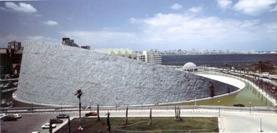
The Library was not destroyed
by the invading Arabs as some stories would have
us believe. It was destroyed much earlier, through
a long decline punctuated with fires and
destruction over four and a half centuries. The
first fire came about during the Alexandrian War,
when Julius Caesar burnt the Egyptian fleet in 48
B.C. and the fire inadvertently spread to the
library buildings near the docks. During the
upheavals of the Roman Empire in the third century
of our era, Alexandria suffered many upheavals and
suppressions which led to the city being invaded
by roman armies several times and the whole royal
district where the old Library and Museum were
located was destroyed. Alexandrian scholarships
moved to the daughter library in the temple of
Serapis (the Serapeum) in the southwest corner of
the city. That too succumbed to destruction in a
wave of anti-pagan actions and the rest of the
Library was burnt in the Serapeum in 391 A.D.
Hypathia (the Mathematician) and the daughter of
the Library's last recorded scholar was brutally
murdered by the mob in 415 AD bringing a final
stop to the seven centuries of Alexandrian
scholarship. That was 230 years before Arnr Ibn El
Aas entered Egypt at the head of the first Arab
Muslim army.
Though 1600 years have
elapsed since the age of the Ancient Library of
Alexandria came to an end, all scholars and
scientists still acknowledge their debt to that
remarkable institution and look with admiration on
the role played by the Ancient Library as a center
for dialogue and tolerance as well as science and
learning.
A brief history of Alexandria across the ages
Alexandria was built in the
shape of a chessboard. It was divided into five
districts, the most important was the Royal
District, which holds the Museum, the Great
Library of Alexandria, the lighthouse and the Sema,
which is the funerary temple where Alexander the
Great was buried.
Dar El Hekma, and the library
were centers spreading culture to the Hellenistic
world. They were also a meeting point for
scientists, great philosophers and men of letters
from various countries. Among Alexandria's
scientists we find Hermophilus, the great surgeon
and Hipparchus considered father of astronomy, and
Archimedes of Syracuse the physicst and others.
The fame of Alexandria's Library surpassed that of
Dar El Hekma as it contained about 700 thousand
biblia.
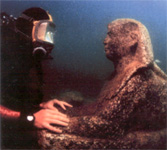
It was the first public
library owned by the state in the ancient world.
We can definitely state that Alexandria was the
center of science, literature and art in the
Hellenistic world during the three centuries of
the Ptolomaic rule.
This page of history was
folded when the Ptolomaic state ended at the hands
of Emperor Augustus, following the battle of
Actium in 30 BC, when Alexandria became the
headquarters of the Roman Prefect until the Arab
conquest in the 7th century AD. Alexandrians role
did not stop at revolutions and sarcasm, they had
a vital role in supporting rebels and those who
wanted to defy the Emperor. They helped Vaspasion
to reach the throne in 69 AD. Failure of the
rebels led the Roman emperors to avenge themselves
on the Alexandrians, an example is what happened
during the rule of Marcus Orerllius (161 -180) and
Sipherios (193 - 2110).
Greek influence prevailed
during the Roman rule. Greek was the official
language of Egypt. From the religious perspective
the Alexandrian triad made up of Serapis, Isis and
Harpocratis deified by the ptolemies remained the
most prominent among the Gods during the Roman
era.
Christianity spread in Egypt
at this period and Copts, experienced religious
persecutions which were at their worse during the
rule of Diocletion, which was referred to as The
Age of Martyrs.
Canope bath water cisterns,
Roman cemeteries, El Anfoushi cemetery, Koum El
Shogafa.
In the second half of the 7th
century following the Arab conquest of Egypt, when
the country was beginning a new era, Alexandria
was no longer the capital of the country due to
the foundation of Fostat. Accordingly, Alexandria
lost its old importance as it broke off from the
Roman World.
It also retained its
commercial prominence because of its outstanding
location that made it the most substantial trade
point between the east and the west. The number of
mansions, palaces, mosques, schools, famous
shrines increased, Alexandria, persisted as the
core of knowledge, culture and the sciences
through her scholars and scientists who came from
the east and the west.
During the period of
independence as from the Abassid State, the
Tulunid State (254 -282 HD -868 -905 AD), the
Akshid State (323 -357 ~D I 995 -968 AD), Fatimid
State (358 -567 HDI 969 - 1172 AD), Egypt managed
to formulate its own independent identity which
reached its peak during the Fatimid period.
Alexandria’s Sunken Treasures
During certain geological
occurrences, namely a series of violent
earthquakes and certain historical outcomes, the
northern parts of the city were affected and sunk
below the depth of the sea, resulting in water
encircling an incredible treasure. The heritage of
the sunken city in the area near the Royal
District and or El Ebrahemia and Mostafa Kamel.
The tremendous importance of sunken antiquities
can be deduced if we consider the large sunken
port below the rocks of Pharos Island, and to the
south west of it, taking into consideration the
fact that the waters of the Mediterranean have
risen two meters since the Roman period.

Actual excavation for sunken
antiquities in Egypt started in the gulf of Abu
Qir in 1933. Serious work connected with
identifying Alexandria's sunken antiquities did
not start in the Royal District until 1961 AD when
the late diver Kamal Aboul Saadat reported seeing
sunken monuments in the depth of the eastern port
area, facing the coast of "Silsilah" and Kait Bey
citadel.
The antiquities department,
with the help of the naval forces, who were
participating for the first time officially,
salvaged a granite statue of a man wearing a cloak
that covered most of his body. The statue was 170
cm in height and was discovered in the first half
of November 1962 AD.
In October 1995, the
expedition of the National French Center for
Studies, began by making a survey of the depth of
the sea. The expedition comprised thirty Egyptian
and French divers specialized in underwater
topographical surveys as well as architectural
hauling and restoration. They conducted their work
in an area of about 2.5 feddans facing Kait Bey
Citadel.
The Egyptian-Greek expedition
recently worked at the area between El Ebrahemia
and Sidi Gaber where it found huge tanks carved in
the rock.
The continuous excavations
under water will clearly reveal the unknown
history of the city by time.
The Bibliotheca Alexandria
(Facts & Figures)
The Site:
The Bibliotheca Alexandrina is located on a
magnificent site in the Eastern Harbor, facing the
sea on the north, and Alexandria University
Complex on its southern side.
It overlooks the Silsilah Peninsula. It is very
close to the location of the Old Library in the
Brucheion (the Ancient Royal Quarter), as verified
by the 1993 archeological survey.
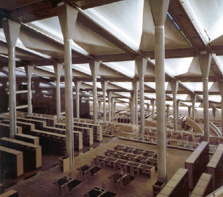
Facts & Figures:
Total floors: 11
Total floor areas: 85,405 m2
Building Height -33 m
Universal Library -36,770 m2
Cultural Activities -4210 m2
Technical Services and Operational Support -10,860
m2
International School of Information Studies (ISIS)
-3500 m2
Conference Center Ancillary Services, Other Areas
-30,840 m2
Books: 200,000 at inauguration 1 up to 8 million
ultimately
Periodicals: 1500/4000
Audio 1 Visual 1 Multimedia
Materials: 10,000150,000
Manuscripts & Rare Books: 10,000/50,000
Maps: 50,000
Computer Data Bases: OPAC, Internet access to the
information superhighways
Library Components:
The Library of Alexandria complex includes: the
Main Library, Young Peoples' Library, Library for
the Blind, Planetarium, Science Museum,
Calligraphy Museum, Alexandria Archeological
Museum, International School of Information
Studies (ISIS), Conservation and
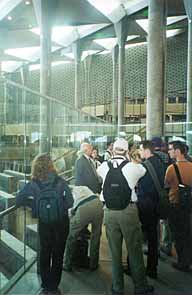 Restoration
Laboratory, Conference Center of Alexandria and
Ancillary Services, Multipurpose Rooms and
Exhibition areas. Restoration
Laboratory, Conference Center of Alexandria and
Ancillary Services, Multipurpose Rooms and
Exhibition areas.
These can be changed or augmented as needs evolve.
Construction Phases:
Phase # 1:
(TPI: Foundations & Geotechnical Engineering)
Contractors: Rodiorrrevi (Italy) / Arab
Contractors (Egypt)
The construction work began on 15/05/1995 and was
completed on 31/12/1996, at the cost of US$ 59
million. The construction work involved the most
advanced technology.
The largest circular reinforced Diaphragm Wall in
the world, 160 m diameter, was a major engineering
achievement, along with more than 600 bored
bell-bottom piles.
Phase # 2:
(TP2/3: Structures, Services, Fit-Out and External
Works)
Contractors: Hal four Heatty (UK) 1 Arab
Contractors (Egypt)
The work began on 27/12/1996, at the cost of US$
117 million. Architects/Engineers (Consultant to
the HA): Snohetta a.s. (Norway)/ Hamza Associates
(Egypt).
|